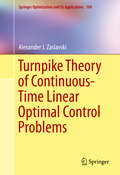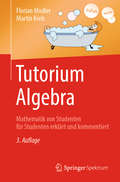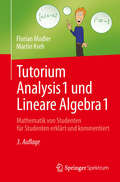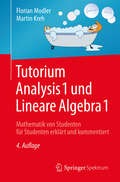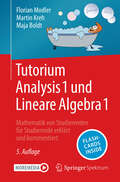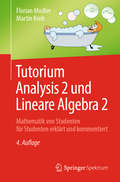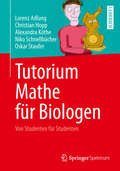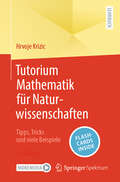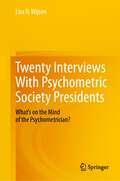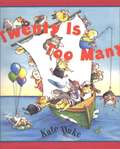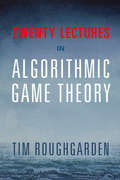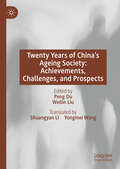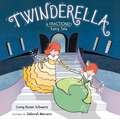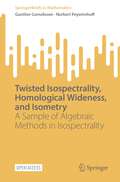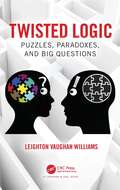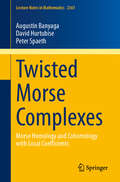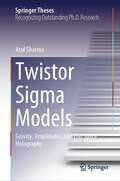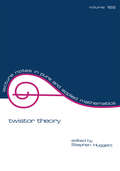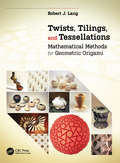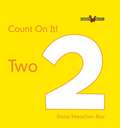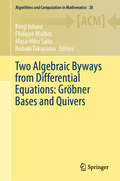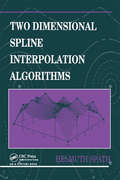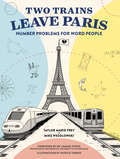- Table View
- List View
Turnpike Theory of Continuous-Time Linear Optimal Control Problems
by Alexander J. ZaslavskiIndividual turnpike results are of great interest due to their numerous applications in engineering and in economic theory; in this book the study is focused on new results of turnpike phenomenon in linear optimal control problems. The book is intended for engineers as well as for mathematicians interested in the calculus of variations, optimal control and in applied functional analysis. Two large classes of problems are studied in more depth. The first class studied in Chapter 2 consists of linear control problems with periodic nonsmooth convex integrands. Chapters 3-5 consist of linear control problems with autonomous convex smooth integrands. Chapter 6 discusses a turnpike property for dynamic zero-sum games with linear constraints. Chapter 7 examines genericity results. In Chapter 8, the description of structure of variational problems with extended-valued integrands is obtained. Chapter 9 ends the exposition with a study of turnpike phenomenon for dynamic games with extended value integrands.
Tutorium Algebra: Mathematik von Studenten für Studenten erklärt und kommentiert
by Martin Kreh Florian ModlerIn einer Algebra-Vorlesung beschäftigt man sich nicht mehr mit Linearer Algebra, sondern es wird abstrakter. Um die Studierenden beim Verständnis für diesen abstrakten Stoff zu unterstützen, erscheint nun mit "Tutorium Algebra" ein weiterer Band der Tutoriums-Reihe der Autoren Modler und Kreh.In dem Buch erläutern die beiden Autoren den Stoff der Algebra. Dabei liegt das Hauptaugenmerk auf der Körpertheorie, genauer der Galoistheorie. Die Inhalte werden an verständlichen und ausführlichen vorgerechneten Beispielen erklärt. Das Konzept bleibt wieder das bewährte: Jedes Kapitel ist zwei geteilt in einen mathematischen Teil, in dem die Definitionen, Sätze und Beweise stehen, und einen erklärenden Teil, in dem die schwierigen Definitionen und Sätze auf gewohnt lockere und lustige Art und Weise mit mehr als 120 Beispielen und etwa 30 Abbildungen mit Leben gefüllt werden.So erhält der Leser einerseits einen Blick für mathematisch exakte Formulierungen und andererseits Hilfen und Anschauungen, die wichtig sind, um den Stoff zu verstehen.Das Buch ist in der 3. Auflage vollständig durchgesehen, verbessert und ergänzt worden. Insbesondere finden sich im Kapitel über Ringe und Ideale einige neue Beispiele (z.B. über den Ring der holomorphen Funktionen) und die Lokalisierung von Ringen wird behandelt. Zudem wurden weitere Kriterien zur Irreduzibilität von Polynomen ergänzt.
Tutorium Analysis 1 und Lineare Algebra 1
by Martin Kreh Florian ModlerDieses Buch soll Ihnen als Mathematik-Erstsemester den Einstieg und Umstieg von der Schulmathematik in die Hochschulmathematik erleichtern und Ihnen somit helfen, viele der üblichen Erstsemester-Fehler zu vermeiden. Das Buch ist anders als alle anderen, denn es wurde von Studenten geschrieben, die Erfahrung als Tutor, Übungsleiter und Korrektoren haben. Dadurch wissen die Autoren zum einen, welche Themen schwer verständlich sind und besonders ausführlich behandelt werden müssen und zum anderen kennen sie häufige Fehler und können auf diese hinweisen. In dem Buch gibt es einen mathematischen Teil, den der Student für Prüfungen beherrschen muss. Bei Fragen oder Problemen kann er dann in dem kommentierten Teil nachschauen und dort ausführliche Erklärungen, Hilfen und Beispiele der Autoren finden.
Tutorium Analysis 1 und Lineare Algebra 1: Mathematik von Studenten für Studenten erklärt und kommentiert
by Martin Kreh Florian ModlerDieses Buch soll Ihnen als Mathematik-Erstsemester den Einstieg und Umstieg von der Schulmathematik in die Hochschulmathematik erleichtern und Ihnen somit helfen, viele der üblichen Erstsemester-Fehler zu vermeiden. Denn aller Anfang ist schwer und die Autoren wollen versuchen, Ihnen den Anfang so leicht wie möglich zu machen und Ihnen helfen, Schwierigkeiten zu überstehen, die im ersten Semester ganz normal sind. Das Buch ist anders als alle anderen, denn es wurde von Studenten geschrieben, die Erfahrung als Tutor, Übungsleiter und Korrektoren haben. Dadurch wissen die Autoren zum einen, welche Themen schwer verständlich sind und besonders ausführlich behandelt werden müssen und zum anderen kennen sie häufige Fehler und können auf diese hinweisen. In dem Buch gibt es einen mathematischen Teil, den der Student für Prüfungen beherrschen muss. Bei Fragen oder Problemen kann er dann in dem kommentierten Teil nachschauen und dort ausführliche Erklärungen, Hilfen und Beispiele der Autoren finden. So verfügt der Leser über zweierlei: Einerseits über die mathematisch exakte Definition oder den mathematisch präzisen Satz und Beweis und anderseits über Hilfen und Anschauungen, die ebenso wichtig sind, um den Stoff zu verstehen.Das Buch ist in der 4. Auflage um weitere Beispiele und zwei Beispielklausuren ergänzt worden. Stimmen zur 1. Auflage: „Es handelt sich also um ein sehr empfehlenswertes Buch für Einsteiger in das Studienfach Mathematik, welches sowohl umfangreich als auch verständlich gestaltet ist.“ Maik Messerschmidt auf www.uni-online.de„Super für den Studienbeginn! Kann dieses Buch nur jedem empfehlen, der im ersten Semester eine Vorlesung in Analysis oder Linearer Algebra hört! Habe schon einige Mathebücher durch und einige Sachen hatte ich trotzdem noch nicht richtig verstanden. Mit Hilfe dieses Buches jedoch wurden viele (komplizierte) Sachverhalte viel verständlicher.“ Kundenrezension auf www.amazon.de
Tutorium Analysis 1 und Lineare Algebra 1: Mathematik von Studierenden für Studierende erklärt und kommentiert
by Martin Kreh Florian Modler Maja BoldtDieses Buch erleichtert euch im ersten Semester des Mathematikstudiums den Einstieg und Umstieg von der Schulmathematik in die Hochschulmathematik. Die Autor*innen machen euch den Einstieg ins Mathestudium so leicht wie möglich: Sie helfen euch dabei, übliche Erstsemester-Fehler zu vermeiden und die Schwierigkeiten zu überstehen, die im ersten Semester ganz normal sind. Schwer verständliche Themen behandeln die Autor*innen besonders ausführlich, auf häufige Fehler weisen sie euch hin. Die essenziellen Inhalte des ersten Semesters werden hier in 21 einzelnen Kapiteln abgedeckt, die jeweils aus zwei sehr verschiedenen Teilen bestehen: Im jeweils ersten Teil findet ihr die mathematisch exakten Definitionen, Sätze und Beweise, die euch auch in euren Vorlesungen begegnen werden. Im jeweils zweiten Teil findet ihr sehr ausführliche und möglichst anschauliche Erklärungen, Hilfen und Beispiele. Bei Fragen und Verständnisproblemen könnt ihr in diesem kommentierten Teil nachschauen. Solltet ihr also irgendeine Definition in der Vorlesung nicht auf Anhieb verstehen, schlagt sie einfach hier nach. Außerdem steht jeweils eine Probeklausur zur Analysis und zur Linearen Algebra zur Verfügung, damit ihr euer erworbenes Wissen testen könnt. Natürlich gibt es dazu auch Musterlösungen. Für die 5. Auflage wurde das Buch nochmals überarbeitet und um gut 230 Flashcards ergänzt, die im Browser oder in der SN-Flashcards-App online abrufbar sind. Mit den Flashcards könnt ihr auch zwischendurch und unterwegs gut weiterlernen und die Inhalte verinnerlichen.
Tutorium Analysis 2 und Lineare Algebra 2: Mathematik von Studenten für Studenten erklärt und kommentiert
by Martin Kreh Florian ModlerNach dem großen Erfolg von "Tutorium Analysis 1 und Lineare Algebra 1" erscheint nun ein Fortsetzungsband der beiden Autoren, mit dem sie den Zweitsemestern und allen, die Analysis 2 und Lineare Algebra 2 oder verwandte Vorlesungen hören müssen, wieder unterstützend unter die Arme greifen.Das Konzept bleibt das Altbewährte: Es gibt wieder einen mathematischen Teil, in dem die Definitionen, Sätze und Beweise stehen, und einen erklärenden Teil, in dem die schwierigen Definitionen und Sätze auf gewohnte lockere und lustige Art und Weise mit vielen Beispielen und Abbildungen mit Leben gefüllt werden.Das Buch ist für die zweite Auflage vollständig durchgesehen und an etlichen Stellen geändert und weiter verbessert.
Tutorium Mathe für Biologen: Von Studenten für Studenten
by Lorenz Adlung Christian Hopp Alexandra Köthe Niko Schnellbächer Oskar StauferWarum ein Mathebuch für Biologen von Studenten für Studenten?Wir wissen, was man an Mathe für Bio wirklich für die Prüfungen und die Bachelorarbeit braucht. Wir haben selbst Bio oder Mathe/Physik studiert und hautnah erlebt, wie unglaublich beliebt Mathe für Biologen ist. Neben einer „natürlichen Abneigung“ liegt es oft daran, dass die Lehre selten anwendungsbezogen ist. Wir haben uns bemüht, in einem Buch nur das aufzuführen, was man als Biologe wirklich benötigt und alles andere konsequent wegzulassen. Es gibt ständig Bezüge zu Publikationen aus den modernen Biowissenschaften. Solche relevanten Beispiele werden euch bestimmt hilfreich sein. Und das Beste: Das Buch ist garantiert häschenfrei! Wir rechnen nicht mit Hasenpopulationen sondern aktuellen Beispielen wie z.B. Signalwegen. Inhaltlich deckt das Buch den Stoff der ersten Mathevorlesungen für Biologen an den meisten Unis ab. Falls ihr mehr wissen möchtet, findet ihr uns auch auf Facebook unter „häschenfreie Mathe“.
Tutorium Mathematik für Naturwissenschaften: Tipps, Tricks und viele Beispiele
by Hrvoje KrizicBist du in deinem ersten Studienjahr und suchst Klarheit in der komplexen Welt der Hochschulmathematik? Dieses Buch richtet sich an Studierende, die Mathematik nicht als Hauptfach studieren, aber dennoch Mathematikvorlesungen in ihrem Studiengang bewältigen müssen. In leicht verständlicher „Studierenden-Sprache“ und mit packenden Beispielen führt dich dieses Buch durch die faszinierende Welt der Mathematik. Hier wird komplexe Theorie auf das Wesentliche reduziert, ohne dabei an Tiefe zu verlieren. Egal, ob du dich auf Prüfungen vorbereitest oder den Vorlesungsstoff während dem Semester vertiefen möchtest, dieses Buch bietet die perfekte Mischung aus intuitiv erklärter Theorie und vorgelösten Aufgaben. Komplexe Themen wie Lineare Algebra und Integralrechnung werden mit Schemata und Tricks so vermittelt, dass partielle Integration und das Gauss-Verfahren dir plötzlich Spaß machen! Erlebe, wie Mathematik nicht nur verständlich, sondern auch faszinierend sein kann. Dieses Buch wird zu deinem verlässlichen Wegbegleiter für Verständnis und Erfolg im Studium – „Tutorium Mathematik für Naturwissenschaften“.
Twelve Landmarks of Twentieth-Century Analysis
by D. Choimet H. Queffélec Michaël Monerau Danièle Gibbons Greg GibbonsThe striking theorems showcased in this book are among the most profound results of twentieth-century analysis. The authors' original approach combines rigorous mathematical proofs with commentary on the underlying ideas to provide a rich insight into these landmarks in mathematics. Results ranging from the proof of Littlewood's conjecture to the Banach–Tarski paradox have been selected for their mathematical beauty as well as educative value and historical role. Placing each theorem in historical perspective, the authors paint a coherent picture of modern analysis and its development, whilst maintaining mathematical rigour with the provision of complete proofs, alternative proofs, worked examples, and more than 150 exercises and solution hints. This edition extends the original French edition of 2009 with a new chapter on partitions, including the Hardy–Ramanujan theorem, and a significant expansion of the existing chapter on the Corona problem.
Twenty Interviews With Psychometric Society Presidents: What’s on the Mind of the Psychometrician?
by Lisa D. WijsenTwenty Interviews with Psychometric Society Presidents tells the stories of the people who are the driving forces of psychometric research, teaching and practice. In semi-structured interviews, twenty presidents of the Psychometric Society share how they moved into the psychometric field, what inspired them to pursue this path, and what still drives them to do their research. They also reflect on the current status, history, and future of their own field, considering psychometrics' most significant historical achievements, as well as the major challenges that lie ahead. This curated collection provides a wealth of historical knowledge that is relevant for every practicing psychometrician. Introspective and insightful, it exhibits the wide array of opinions and visions in the field. Readers are invited to critically reflect on what holds this diverse field together, and what challenges and opportunities are on the horizon.
Twenty Is Too Many
by Kate DukeTwenty guinea pigs can be too many--especially if all of them are crammed on a small and tipsy boat. In this charming and boisterous book about subtraction, the guinea pigs begin to jump ship, each in his or her own funny and unique way. While children follow the story of the ever-shrinking gang of guinea pigs, they can count the furry pals leaping on and around oversized numerals representing the number of cavorting cavies on the page. A simple equation that shows the subtraction is printed along the bottom of each spread, reinforcing the concept.Like its successful predecessor, One Guinea Pig Is Not Enough, this book tells a story while teaching a number concept.
Twenty Lectures on Algorithmic Game Theory
by Tim RoughgardenComputer science and economics have engaged in a lively interaction over the past fifteen years, resulting in the new field of algorithmic game theory. Many problems that are central to modern computer science, ranging from resource allocation in large networks to online advertising, involve interactions between multiple self-interested parties. Economics and game theory offer a host of useful models and definitions to reason about such problems. The flow of ideas also travels in the other direction, and concepts from computer science are increasingly important in economics. This book grew out of the author's Stanford University course on algorithmic game theory, and aims to give students and other newcomers a quick and accessible introduction to many of the most important concepts in the field. The book also includes case studies on online advertising, wireless spectrum auctions, kidney exchange, and network management.
Twenty Years of China’s Ageing Society: Achievements, Challenges, and Prospects
by Peng Du Weilin LiuThis book is an in-depth study of the ageing problem in China from a multidisciplinary perspective. For the first time in Chinese history, it systematically summarizes the development process, achievements and challenges of China from the year 2000 to 2020, and illustrates the exploration process of the theory and practice to actively address population ageing with Chinese characteristics.
Twinderella, A Fractioned Fairy Tale
by Corey Rosen SchwartzTurns out you only know half of the story of Cinderella. Learn the rest in this mathmatically enjoyable fractioned fairy tale!Cinderella had a twin sister, Tinderella. They each did half the housework, half the mending, and half the mean step-sister tending. But when they meet only one prince, what will they do? The whole story has twice the magic and double the fun! From the author The Three Ninja Pigs comes the fractioned fairy tale of Cinderella and her less-famous sister.
Twisted Isospectrality, Homological Wideness, and Isometry: A Sample of Algebraic Methods in Isospectrality (SpringerBriefs in Mathematics)
by Norbert Peyerimhoff Gunther CornelissenThe question of reconstructing a geometric shape from spectra of operators (such as the Laplace operator) is decades old and an active area of research in mathematics and mathematical physics. This book focusses on the case of compact Riemannian manifolds, and, in particular, the question whether one can find finitely many natural operators that determine whether two such manifolds are isometric (coverings).The methods outlined in the book fit into the tradition of the famous work of Sunada on the construction of isospectral, non-isometric manifolds, and thus do not focus on analytic techniques, but rather on algebraic methods: in particular, the analogy with constructions in number theory, methods from representation theory, and from algebraic topology.The main goal of the book is to present the construction of finitely many “twisted” Laplace operators whose spectrum determines covering equivalence of two Riemannian manifolds.The book has a leisure pace and presents details and examples that are hard to find in the literature, concerning: fiber products of manifolds and orbifolds, the distinction between the spectrum and the spectral zeta function for general operators, strong isospectrality, twisted Laplacians, the action of isometry groups on homology groups, monomial structures on group representations, geometric and group-theoretical realisation of coverings with wreath products as covering groups, and “class field theory” for manifolds. The book contains a wealth of worked examples and open problems. After perusing the book, the reader will have a comfortable working knowledge of the algebraic approach to isospectrality. This is an open access book.
Twisted Logic: Puzzles, Paradoxes, and Big Questions
by Leighton Vaughan WilliamsTwisted Logic: Puzzles, Paradoxes, and Big Questions delves into the intriguing world of twisted logic, where everyday conundrums, bewildering paradoxes, and life's big questions are investigated and decoded. Crafted for the curious mind, this book sheds light on how our intuition and common sense can often mislead us. Without the need for technical jargon or mathematical prowess, it serves as your personal compass through fascinating intellectual landscapes and ultimate explorations. From the quirky corners of Bayesian reasoning to practical strategies in daily choices, this is your companion for a clearer way of thinking.Features: A comprehensive toolkit to refine your cognitive processes and avoid common pitfalls. Insights into the oddities of probability, strategy, and fate that govern our lives. A fresh perspective on everyday decisions and life's larger dilemmas, including finding everything from a place to eat to a new home to a life partner. Practical advice on optimising daily routines, such as determining the best time of day to arrange important appointments. Thought-provoking 'When Should We?' questions that challenge us to think critically about decision-making in our lives. Prepare to challenge your perceptions and unveil hidden truths. Twisted Logic is an enlightening adventure that promises to transform the mundane into the extraordinary. Embark on a journey where the only thing certain is the thrill of the unknown.
Twisted Morse Complexes: Morse Homology and Cohomology with Local Coefficients (Lecture Notes in Mathematics #2361)
by Augustin Banyaga David Hurtubise Peter SpaethThis book gives a detailed presentation of twisted Morse homology and cohomology on closed finite-dimensional smooth manifolds. It contains a complete proof of the Twisted Morse Homology Theorem, which says that on a closed finite-dimensional smooth manifold the homology of the Morse–Smale–Witten chain complex with coefficients in a bundle of abelian groups G is isomorphic to the singular homology of the manifold with coefficients in G. It also includes proofs of twisted Morse-theoretic versions of well-known theorems such as Eilenberg's Theorem, the Poincaré Lemma, and the de Rham Theorem. The effectiveness of twisted Morse complexes is demonstrated by computing the Lichnerowicz cohomology of surfaces, giving obstructions to spaces being associative H-spaces, and computing Novikov numbers. Suitable for a graduate level course, the book may also be used as a reference for graduate students and working mathematicians or physicists.
Twistor Sigma Models: Gravity, Amplitudes, and Flat Space Holography (Springer Theses)
by Atul SharmaIn recent decades, twistor theory has grown into an irreplaceable tool for the study of scattering amplitudes in gauge theory and gravity. This book introduces the reader to cutting-edge advances in twistor theory and its applications to general relativity. The problem of graviton scattering in four dimensions is shown to be dual to dramatically simpler computations in a two-dimensional CFT known as a twistor sigma model. Twistor sigma models are the first step toward a holographic description of gravity in asymptotically flat space-times. They underpin the infinitely many asymptotic symmetries of flat space physics discovered in celestial holography, and extend them to exciting new arenas like curved space-times. They also yield intrinsically mathematical results in the field of hyperkähler manifolds. This volume will be of broad interest to students and researchers looking for an accessible entry point into twistor geometry, scattering amplitudes, and celestial holography. It will also provide an invaluable reference for specialists by bringing together results from a host of different disciplines.
Twistor Theory
by AuthorPresents the proceedings of the recently held conference at the University of Plymouth. Papers describe recent work by leading researchers in twistor theory and cover a wide range of subjects, including conformal invariants, integral transforms, Einstein equations, anti-self-dual Riemannian 4-manifolds, deformation theory, 4-dimensional conformal structures, and more.;The book is intended for complex geometers and analysts, theoretical physicists, and graduate students in complex analysis, complex differential geometry, and mathematical physics.
Twists, Tilings, and Tessellations: Mathematical Methods for Geometric Origami (AK Peters/CRC Recreational Mathematics Series)
by Robert J. LangTwists, Tilings, and Tessellation describes the underlying principles and mathematics of the broad and exciting field of abstract and mathematical origami, most notably the field of origami tessellations. It contains folding instructions, underlying principles, mathematical concepts, and many beautiful photos of the latest work in this fast-expanding field.
Two (Bookworms Count on It!)
by Dana Meachen RauPublisher's summary: Identifies things that inherently come in twos and lists other examples. The simple and engaging text and photos of Count On It! accomplish two things at once: They teach children how to count as well as to read. The direct correspondence between image and text and consistent format make these books ideal for the beginning reader and mathematician.
Two Algebraic Byways from Differential Equations: Gröbner Bases and Quivers (Algorithms and Computation in Mathematics #28)
by Kenji Iohara Philippe Malbos Masa-Hiko Saito Nobuki TakayamaThis edited volume presents a fascinating collection of lecture notes focusing on differential equations from two viewpoints: formal calculus (through the theory of Gröbner bases) and geometry (via quiver theory). Gröbner bases serve as effective models for computation in algebras of various types. Although the theory of Gröbner bases was developed in the second half of the 20th century, many works on computational methods in algebra were published well before the introduction of the modern algebraic language. Since then, new algorithms have been developed and the theory itself has greatly expanded. In comparison, diagrammatic methods in representation theory are relatively new, with the quiver varieties only being introduced – with big impact – in the 1990s. Divided into two parts, the book first discusses the theory of Gröbner bases in their commutative and noncommutative contexts, with a focus on algorithmic aspects and applications of Gröbner bases to analysis on systems of partial differential equations, effective analysis on rings of differential operators, and homological algebra. It then introduces representations of quivers, quiver varieties and their applications to the moduli spaces of meromorphic connections on the complex projective line. While no particular reader background is assumed, the book is intended for graduate students in mathematics, engineering and related fields, as well as researchers and scholars.
Two Dimensional Spline Interpolation Algorithms
by Helmuth SpäthThese volumes present a practical introduction to computing spline functions, the fundamental tools for fitting curves and surfaces in computer-aided deisgn (CAD) and computer graphics.
Two Eyes, Two Ears (Into Reading, Level D #78)
by Annette Smith Lindsay EdwardsNIMAC-sourced textbook
Two Trains Leave Paris: Number Problems for Word People
by Taylor Frey Mike WesolowskiEntertaining word problems that let verbal types master the language of math!Math is a universal language, but it’s also the least understood and most undervalued subject taught in school. Two Trains Leave Paris: Number Problems for Word People offers an opportunity to experience math like never before. You must use the Pythagorean Theorem to figure out how far apart two ex-lovers are when they simultaneously realize that they cannot live without each other. You must use addition (and logic) to explore the ridiculous (and patriarchal!) wage gap. Throughout six math-themed chapters, readers will follow a series of characters as they apply for jobs, fall in love, get abducted by aliens, and experience many of life’s other big and small moments, all of which are dictated by—you guessed it—math! With the help of humor, mathematical history, and how-to-solve sections, Two Trains Leave Paris asks readers to help its characters find growth in the most unexpected of places: word problems. And the answers are, of course, in the back.
